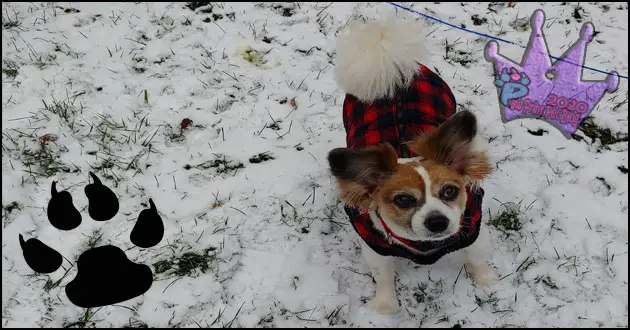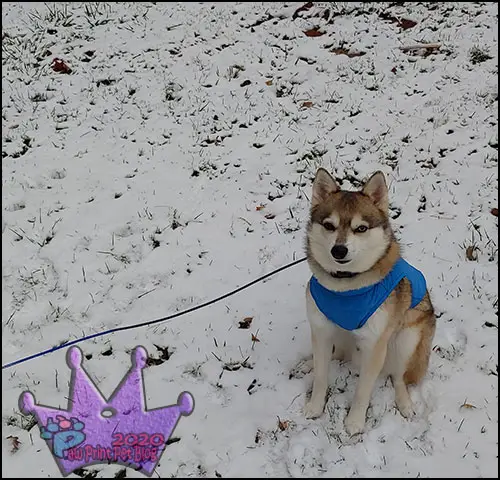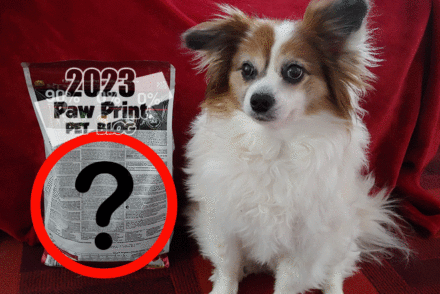
When we still lived in the city, snowy/icy weather always meant it was time to break out my dogs’ boots. Without their boots we would never get far in our walks before the boys would start limping. The large amounts of salt put out by the city/neighbors burned their paws. Now that have more control over what type of products are used, we make sure to use pet friendly products.
Post Contents:
- 1 Exposure to traditional ice melts, usually made from salts, can injure your furry friend’s feet in a few different ways.
- 2 Many kinds of ice melts are also bad for the environment.
- 3 So what are the alternatives to traditional salt based ice melt products?
- 4 If there’s some reason why you must use salt based ice melters, always follow the directions closely.
Exposure to traditional ice melts, usually made from salts, can injure your furry friend’s feet in a few different ways.
Salt crystals can be irritating if they get caught between doggy toes, and sharp crystals can even cut or puncture pet’s paw pads. Salt is also drying, and can cause the pads of animals’ feet to become dry, cracked, and sore. Exposure to traditional ice melt products can also cause chemical burns on animals feet, skin, mouths, and digestive systems (if they consume any of the product).
Many kinds of ice melts are also bad for the environment.
Ice melt can kill or damage plants. It can be carried in runoff to contaminate local bodies of water. It is damaging to the plants and animals that live there. Even if you don’t have any pets, or care for the environment, ice melt products can also damage lawns, contaminate waterways, and damage asphalt, concrete, wood, rugs and wood floors (if tracked inside).
This post contains affiliate links. If you click on one of our links and complete an order, we will receive a small commission at no additional cost to you. Please see our Disclaimer page for more information.
 So what are the alternatives to traditional salt based ice melt products?
So what are the alternatives to traditional salt based ice melt products?
Some companies sell pet and/or environmentally friendly products that do not contain salts. The safest and cheapest alternative is to use sand to create traction on icy areas rather then using products that melt the ice. Sand is much safer for animals, children, and the environment. The ice will melt naturally anyways, or can be chipped away after it’s allowed to soften a bit, and in the meantime covering it with sand makes it safer to walk on.
If there’s some reason why you must use salt based ice melters, always follow the directions closely.
A little bit goes a long way! Applying too much salt not only increases its’ negative impacts on plants and animals. It can also make the product less effective at melting ice. If you, like was once the case with me, can’t control what types of products are used around your home, consider protecting your pet’s paws with booties, or by using paw protecting products such as Musher’s Secret, and always rinse or wipe your pet’s paws and fur off after returning from a winter walk.
My partner and I joke that we now live in the ‘frozen north’. The area we live in now gets quite a bit colder than the city we left. We’ve been dealing with all the fun seasonal stuff like snow, ice, cold, power outages – oh my! The town we live in gets an average of 75 inches of snowfall a year. As you can imagine, we’re getting some experience dealing with cold, icy weather. Thankfully, in the time we’ve been here so far, we’ve had a lot of success keeping the area around our home safe and ice free with all pet/environmentally friendly products. Afterall, keeping ourselves and visitors (aka the UPS person) safe is important, but keeping my pets and the environment healthy and safe is important to me too!





10 Comments
As I do not live in a snowy area this is something I have never thought about so for me it was really interesting to read and learn from, You are fortunate to live out of the city today and control things more as it must ease your mind a lot plus keep your dogs healthier.
Thank you! We for sure did our time in the city, and worked hard to be able to leave it behind. It’s been very nice to have more control over how the area around our home is taken care of. It’s a lot more work for us, having to do everything ourselves now, but SO worth it!
We avoid ice melts too; much easier now, living in the middle of nowhere. Where we have icy spots, we use sand. Having a wood stove now too, ashes work even better. Just a tiny cover with even the finest ashes create amazing traction.
One time, when I was desperate during awful freezing rain, I mixed the sand with Epsom salt. LOL I don’t know if it helped but I do know it’s easy on my dog’s feet. Nobody got hurt so I guess that worked.
Wood stove ashes is a great idea too! I never thought of that. We don’t have one at our current place but maybe someday, so I’ll have to keep that in mind.
Sounds like the Epsom salt worked! I hear ya on the getting desperate. Last year, our first year here, we really underestimated how much sand and pet safe ice melt we’d need to get through the winter. I think we’ll be much better prepared this winter.
Ah yes the winter season is upon us and I’m very familiar with dealing with snow and ice.Luckily I don’t have to distribute any “melt” myself however I have seen both traditional ice melt and sand used. Also some people use cat litter to help give traction if their car gets stuck. Interesting trick I never knew about. Thanks for sharing this helpful and environmentally safe information.
I’ve heard of using cat litter too! A convenient option if you have cats and already have the litter around anyways. Although I suppose we could buy litter and keep it in the car, we’ve always had good luck with sand so just stick with that.
I grew up further north and the township even uses sand instead of salt on the roads there. Moving down here, I was met with the fact that salt is used EVERYWHERE, so we had to adjust the ways that we prepared for the winter weather. We purchased boots for the dogs so that we can still take them walking off our property. However, on our own property, we stick to a dog-friendly ice melt. I hadn’t considered the impact of the salt on our yards, but I’ve always been bothered by the amount of salt used around here with our area literally surrounded by bodies of water. The runoff has to be causing damage, whether people want to admit it or not…
Our town uses sand too! I remember thinking that was really cool our first winter here, to not have to deal with the salt. In the city we used to live they went so crazy with the amount of salt they used. I get wanting to keep everyone safe but it was so excessive. We didn’t have the option of not putting boots on the dogs in the winter there because the building we lived in didn’t have a front yard, so there was no buffer area between our house and the sidewalk/road where all the salt was. Salt runoff for sure is damaging to waterways! I have a wildlife biology degree, and I can still remember in one of my ecology classes learning how bad for the environment all the salt runoff is.
When I grew up everyone used ice melt and I think back to that time and am so thankful we didn’t have any issues with our dog (our neighbor’s did have a problem though – so we slowly learned that it was due to the melt). Fast forward to today and we use sand – not only does it work better for gripping your shoes but it is so much more safe for critters (all of them – birds, bunnies, kitties, and dogs)!
I wish cities would modernize their winter protocols and maybe stop using so much salt. The town we live in now gets way more snow/ice than the city we left, and they don’t even salt the roads here – they just use sand. It’s SO much safer for the environment and, like you said, all the animals!